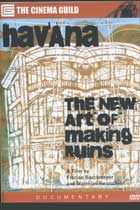
Havana: The New Art of Making Ruins 2006
Distributed by Cinema Guild, 115 West 30th Street, Suite 800, New York, NY 10001; 212-685-6242
Produced by Florian Borchmeyer and Matthias Hentschler
Directed by Florian Borchmeyer and Matthias Hentschler
DVD, color with b&, 52 min.
Jr. High - Adult
Latin American Studies, Political Studies, Social Sciences, Sociology, Urban Studies
Date Entered: 10/02/2007
Reviewed by Holly Ackerman, Duke UniversityBorchmeyer and Hentschler have created a beautiful, nostalgic film that is vibrantly peopled by four individuals living in ruined buildings in Havana. A theory of the ruins and what they represent is threaded through the film by the observations of Cuban author Antonio José Ponte. Ponte argues that the physical decay of Havana is a metaphor for the political decline of Fidel Castro and that the ruined city symbolizes the often predicted U.S. invasion that never came.
For the most part, however, politics is not at the heart of the film. Four fascinating life stories form the center. A beautiful young woman who left her abusive but well placed husband now lives in a ruin where she writes stories about perfect worlds as the building literally falls down around her. An elderly couple still living on a portion of their once grand country estate recalls a more bountiful past but provide an example of the solidity of personal commitment. A former janitor of the collapsing Campoamor Theater lives in the condemned building remembering past performances. A divorced couple live in separate decaying structures while the husband devotes himself to maintaining his apartment building and sublimating his desire to fly away by raising pigeons.
The film exists in two forms, the one listed above and as a longer commercial version (86 minutes). The commercial cut provides more biographical information on the four protagonists. Of the two, I preferred the shorter version which has a better flow of the storyline and tighter cinematography. Either version is worth seeing just for the visual impact of Havana’s ruins and its endless appeal.
- Awards:
- Special Jury Award, LA Latino International Film Festival, 2006